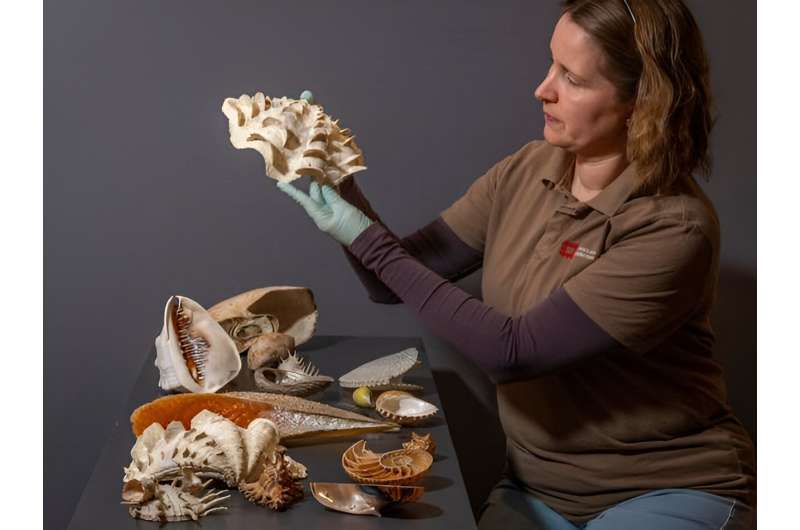This article has been reviewed according to Science X's editorial process and policies. Editors have highlighted the following attributes while ensuring the content's credibility:
fact-checked
trusted source
written by researcher(s)
proofread
This 18th-century shell collection, saved from a skip, tells a story of empire, explorers and women's equality

In the 1980s, a shell collection that included specimens from Captain Cook's final voyage was accidentally thrown into a skip and believed lost forever. But much to the joy of scientists, last week it was rediscovered safe and sound and donated to English Heritage.
Her name might not have made the headlines, but the woman who originally collected the shells, Bridget Atkinson (1732-1814), made a significant contribution to natural history in the 18th century.
Atkinson was one of many women interested in shells at this time. It was a pursuit that drew in both aristocratic and middle-class enthusiasts. Among them were famous collectors, such as the philosopher and poet Margaret Cavendish and cousins Jane and Mary Parminter, the elite owners of the shell-encrusted house A la Ronde, in Exmouth.
Collecting shells was a common pastime in Enlightenment Britain. This was a period in which elite women were becoming increasingly interested in the sciences, and they pursued its disciplines with wild enthusiasm.
This is demonstrated in the popularity of books such as Newtonianism for Ladies by Francesco Algarotti. Published in 1737, the book was a bestseller and reprinted many times as the 18th century progressed.
Botany and natural history were deemed particularly appropriate vehicles for women's intellectual curiosity. Women engaged in these practices were encouraged to collect specimens, create displays and study related literature, often written by female authors.
As a result, the early 19th century saw the publication of various natural history books written by women, such as The Conchologist's Companion by Mary Roberts (1824), a series of letters on the properties of various types of shell.
Atkinson's collection
While Atkinson wasn't unusual as a woman collecting shells, the extent of her acquisitions sets them apart from many other collections of the period. She acquired as many as 1,200 shells throughout her lifetime, with many sourced from far-flung regions across the globe.
Atkinson was from a wealthy and genteel, but not aristocratic, family, and as a result, she is not as well known as other shell collectors of the time. Nevertheless, her collection includes a number of important specimens of endangered and protected species. Many were amassed from her connection to George Dixon, an armorer on Captain Cook's third and final world voyage.
While her surviving correspondence shows her to be a less-than-perfect writer, Atikinson's expertise in natural history led to her becoming the first female honorary member of the Society of Antiquaries of Newcastle upon Tyne in 1813. Women were still deemed ineligible for full membership until 1877.
Atkinson's collection does not simply reflect the scientific interests of a curious individual. A study of their acquisition reveals a broad, even global, system at play. A number of her shells were gifted to Atkinson through the networks of the British Empire.
Several members of Atkinson's family were employed in imperial roles. Her son and brother-in-law were both a part of the mercantile colonizing forces of the East India Company, and the latter even owned sugar plantations in Jamaica. This means the Atkinson family were direct beneficiaries of the enslavement of Black men and women in the Caribbean.
Atkinson used these connections to her advantage, writing to her relatives living abroad to ask for shells and even imploring family friends to do the same. In 1796, her friend Mary Yates wrote to her son John, who then lived in Virginia, to pass on Atkinson's request for "snail shells picked off the ground …the larger the better".
Conveyed through the very routes and mechanics of the British empire, Atkinson's collections are indivisible from the wider history of colonialism. This is something that future displays of the shells will inevitably have to address.
The history of Atkinson's collection
Despite their obvious significance today, Atkinson's shells have not always been treated with reverence. The collection was passed down through various generations of the Atkinson family before eventually being acquired by Newcastle University in the 1930s (then known as King's College). It was in this time that the shells were lost.
Having been discarded into a skip, an eagle-eyed marine zoologist named John Buchanan rescued them from obscurity. Going through his belongings after his death, his family discovered the collection and donated it to English Heritage.
This is not an unusual story. Viewed as trifling interests and trivial pursuits, a lack of interest in women's collections of shells, both ornamental and scientific, has led to many examples being lost over the centuries.
The great sale of Margaret Cavendish's collection in 1786 is a typical example. Her shells and corals from Britain, Italy and the Indian Ocean were all placed all for sale, alongside those collected for decorative purposes. Like Atkinson's collection, Cavendish's shells included specimens from Cook's travels. But even this important association did not save them from being scattered widely.
As Atkinson's shells reveal, the collection of these beautiful natural objects crossed continents, told vivid histories of imperialism and established women's vital role in the development of natural history as a discipline. Their forthcoming display at Chester's Roman Fort and Museum will ensure that they continue to tell these stories long into the future.
Provided by The Conversation
This article is republished from The Conversation under a Creative Commons license. Read the original article.![]()





















